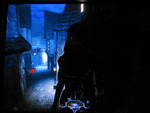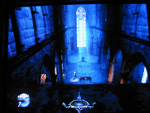Our recent trip to ION Storm let us play and analyze Thief: Deadly Shadows (TDS) to give the public an opinion on how TDS has been shaping up, nearing its release. ION Storm was kind enough to provide us with both a PC and an Xbox to thoroughly play and test the game on. With our controllers, mice, and keyboard in hand, the lights off and the headphones on, we were ready to take our trip out of ION Storm and into “the City” for some loot and pick pocketing.
Coming from more console roots than the other wannabe-Thief, Dan, who was also at ION Storm, I spent my trip playing the XBox version of TDS. In his hands-on preview, Dan has beautifully covered all aspects of TDS such as weapons, the inclusion of 3rd person perspective, and everything else you’ll think of, so I won’t reiterate and instead will be mainly discussing the Xbox controls and gameplay, and general Thief: DS impressions and conclusions.
Let’s get started.
XBox Controls
Playing first-person perspective games on a console always initially raises my suspicion, primarily because the fact that analog sticks on a console controller aren’t as accurate as using a “mouselook” based system. Was I nervous that TDS would be tedious on an Xbox? You bet. Were my suspicions doused? Oh yes. TDS runs great on an Xbox and I never had a problem with tedious control systems that engulf other first-person games on consoles. Let me explain.
The Xbox has 2 analog sticks, four buttons labeled A, B, X, Y, two trigger buttons (L, R), a white and black button, and finally the Back and Start buttons. There are several different controller configurations that you can choose (unlike the PC version, you can’t map the button to however you like). The default setting, however, was suitable I felt. The left analog stick controlled moving forward/backward and side-stepping. The right analog stick controlled turning left/right and looking up/down. I have played other first-person perspective games like Halo, Timesplitters 2 and yet TDS felt more fluid in analog movement than the other games. One thing good about Looking Glass games was the speed of the player was slower than high-paced action games like Doom and Quake, and TDS I feel has the same movement. The A button is the primary action button of the game, to open doors, chests, read books, scrolls, and more. The B button is used to lean against the wall to further hide you from your enemies and friends alike. The X button toggles Garrett from crouching/standing up, and the Y button makes Garrett jump/mantle.
You would use the L trigger to use your non-weapon items in your inventory, which includes healing potions, flash bombs, gas bombs, and other goodies. The R trigger is used to use your weapons (blackjack, bow and arrow, dagger, etc). The black button on the Xbox toggles through your non-weapon items (which are used with the L trigger), and the white button toggles through your weapons (which are used with the R trigger). You can either keep pressing the white/black buttons to keep going through your inventory, or you can hold either button down, and use your left analog stick to scroll through your inventory.
The D-pad on the controller lets you do a couple of things. By pressing left/right, Garrett will be able to lean in that direction, something which definitely comes in handy if you want to peer down hallways while keeping your body hidden behind a wall. The up/down portion of the D-pad controls Garrett’s mechanical eye. Pressing up/down zooms in/out, respectively.
Finally, the Back button toggles between first and third-person perspectives. The start button takes you to the menu, where you can view your objectives, inventory, and game options (sound, video, etc). You can also view your map(s) for the mission you are on as well through the menu. Because the XBox doesn’t have a mouse, you can’t move the cursor freely across the screen. You control the cursor with the analog stick to move between the different menus and options. Whenever you want to go up one ‘level’ you simply press the Back button on the controller.
Now, what are the differences in the controls between the Xbox and PC versions of TDS? For starters, lock-picking on the Xbox enables the force-feedback on the controller, so you feel different levels of “rumble” as you get closer or farther away from a successful pick. It does make lock-picking easier, especially when you’re in a hurry (while a guard is coming your way!) but you can always turn the rumble off if you’re a purist in playing everything to the hardest level possible.
Now that we got the controls out of the way, how does the game feel playing with a controller? It feels just fine. All my suspicions have been cleared away, and I think yours should also (those of you planning on getting the Xbox version). Within 5 minutes of playing the tutorial I was moving as fluid as if I were playing with keyboard and mouse on the PC. My only minor gripe, however, is that when you select to fire an arrow (any one), you press R to nock your arrow back. As you do that, you use the right analog stick to aim where you want to fire the arrow. The movement of aiming was a little too fast, so it was hard to aim at first. After shooting a couple of arrows, though, I got used to it. One other cool feature is that if you nock your arrow back and then you change your mind, all you have to do is *slowly* release the R trigger and you’ll see Garrett slowly un-nock his arrow.
Graphics
I’ve always been surprised at how today’s generation of consoles can display great graphics on a television screen. Thief: Deadly Shadows is no exception. While the PC version has higher-resolution textures (due to the 64MB RAM limitation on the Xbox), the game is definitely no slouch. ION Storm thankfully did not leave anything out of the Xbox version to help the game run faster or smoother. You still see your shadows casting on the wall as you walk/crouch by, the moonlight shimmers through the windows (creating a very cool effect), the dynamic lighting system in the game works exactly as it works in the PC version, the character animations are no less fluid or choppier than its PC counterpart, just to name a few things. I didn’t notice any slowdowns in the game or sudden frame rate drops; everything was constantly silky smooth. One of the things I noticed was that the default brightness setting on the Xbox version was darker than the PC version, but then again, that could have been just the TV I was using. You can either remedy that by either adjusting the in-game brightness controls or the controls on the TV itself.
Rest assured though that with Thief: Deadly Shadows you are getting as almost as much, cosmetically, as you are with the PC version. For me personally, the difference in graphical quality doesn’t justify reasoning for purchasing the PC version instead.
Sound
Sound plays a huge role in the Thief games, because a majority of the gameplay concept revolves around sound, whether it is your movement within the game’s different environments, knowing where others are with respect to your current position, or other sound-related situations. Suffice it to say that any Thief game that doesn’t have good sound mechanics will be like playing basketball with a broken arm. Not only does Thief: DS avoid this problem, it shows off this feature with great implementation and flexibility. Thief: DS uses the latest in Dolby Surround Sound technology, giving the game great use of sound propagation (the realistic movement of sound within environments). You can hear your own (and others) footsteps on different surfaces (wood, metal, carpet, etc), and you can hear enemies and civilians in all dimensions (above you, below you, behind closed doors). Sounds are properly muffled when listening between walls, or when doors are closed (the levels of volume are also taken into consideration with the different thicknesses of walls and types of doors). Sound also plays an important role in creating player immersion and the developers at ION Storm knew sound plays a crucial role into making a game that is so reliant on it, so their efforts have not gone unnoticed. You’ll be utterly impressed.
As I mentioned earlier, Thief: DS on the Xbox does take advantage of Dolby 5.1 support, so those of you with state-of-the-art sound systems are in for a real treat. I got the chance to play the game on stereo headphones and that was also a delight. If I had a choice between playing with or without headphones, I would choose with headphones -- just because I would want to get the in-your-face (or in this case, ears) experience. Sure, the chance of you jumping out of your seat is greater, but I’ll gladly take that risk!
Artificial Intelligence
Any single-player game released these days needs a very crucial element: good artificial intelligence (AI). Without good AI, you’ll be playing a game without challenge, without action, without consequence, and without fun. In his article, Dan stated how advanced the AI in Thief: DS is, and I will re-iterate it as well – the AI in Thief: DS is stunning. You truly feel like the characters in the game have emotions, life-like reactions to your actions, and because of this, the AI also creates tension in the game. Tension that is much needed.
Here’s an example: I had recently sneaked past a civilian, who was walking around a small den. As I left the room and entered a narrow hallway, I quickly saw a guard up ahead who was about to turn around and face me. In fright, I quickly turned around and went back the way I came, but this time, the civilian noticed something moving in the light. He quickly said “Guards! I just saw someone!” (not his exact words, but work with me here). I quickly exit the room again, go across the hallway and hide in the shadows in the adjacent room and wait to see if the commotion clears. I can hear a guard walking around near where I was noticed, peering around the rooms and hallways to see where the scoundrel has gone. After a couple of minutes of searching, I hear the guard leave the area I was in and surprisingly, he started searching the entire den!
Now I’m not saying the AI in Thief is 100% perfect. No game has perfect AI. I noticed glitches sometimes with the guards when I would get spotted, but nothing major or tension-breaking.
Gameplay Impressions
I like to think of Thief 1 and 2 as being games that brought player immersion to a new level. Looking Glass Studios always tried surrounding themselves with game design aesthetics that revolved around immersion and so-called “interactive simulations", and for the most part they succeeded. Thief: Deadly Shadows also attempts to give the player the same sort of immersive player experience. As soon as you are in the footsteps of Garrett, they want to keep you there until you hit the power button on your Xbox. Did they succeed? To me, oh yes.
A key aspect in creating player immersion is to surround the player with an extensive environment; game systems and mechanics, rules, and interactivity that give the player a large pool of dynamics, but from there, let the player decide how to accomplish the objectives and how game systems interact with one another. This creates open-ended gameplay, and allows the player to truly be himself/herself when playing the game. What fun is there in playing another person’s game? By playing the game the way you want to play it creates immersion and further creates the “fun” factor. Thief: DS accomplishes a lot in giving the player choices and allowing the player to create and play their own version of Garrett.
Here’s an example. In one of the earlier missions, one of your objectives is to steal an artifact from a room in which contains several guards and other characters. The game recommends for you to ring a bell on the other side of the level to lure the characters out of that room so you can sneak in and steal what you need.
Instead of doing that, I went up to the door, opened it and quickly threw a flash bomb inside. That gave me about 5 seconds to make my move, so I quickly crept inside, got what I needed, left the room (I closed the door as I left), and subsequently they started searching frantically for the cause of their disruption. I grinned in pleasure, and definitely felt that I was making an impact on how Garrett should act.
The controls of the game on the Xbox controller really add to the gameplay and immersion. Meaning, if the controls weren’t as fluid as they are, the immersion could be really broken at will. The entire experience, from the controls, graphics, sound, to the AI and the game mechanics really build the player immersion, and therefore, the gameplay. It’s like a puzzle; without one of the pieces, the puzzle isn’t completed.
I could go on and on about how the game plays and what levels contain what and how to go about playing the game, but I don’t want to spoil anything, so I just wanted to talk about the core aspects of the gameplay and what makes the game “fun”.
Enough mumbo-jumbo talk about immersion – is it fun and is it Thief?
Yes and yes. The game becomes fun when you add all these elements. Would a game be fun if it held your hand the entire time? Would a game be fun if you didn’t have any input on how the game should be played? If you answered yes to any of those questions, then look elsewhere for a game like Thief is probably not your cup of tea.
The Thief team at ION Storm set out to create an environment in which you play a master-thief and get to experience the aspects of a stealth-based game. They want to give the controls to the player and let them decide their actions and consequences. Did they succeed at accomplishing this goal? I certainly think so. If you always wanted to play the role of a thief and want to experience it first-hand, Thief: Deadly Shadows is calling your name. If you are a gamer that is in need of something fresh, something that oozes atmosphere, something that lets you lose yourself and then find yourself in the world of Garrett then this definitely has appeal to you.
Xbox or PC?
This article was to mainly talk about the Xbox aspects of the game and why Xbox gamers should pick up this game. It also serves as information for the PC gamer that owns an Xbox, and whether or not to pick up the Xbox version instead of the PC version.
Personally, I have been a PC gamer my entire life. Only recently have I been getting into consoles. Consoles have come to a point now where they are more or less as technically able as today’s average gaming PC, and much more powerful than the consoles of yesteryear, such as the Nintendo 64 or Playstation 1. Furthermore, consoles have the upper edge in convenience and accessibility; nothing beats coming home after a long day of work, jumping on your couch, turning on your TV and Xbox, and start playing Thief on your 55-inch high-definition TV with your 5.1 Dolby Surround Sound system. Because of that, I am leaning more towards the Xbox version. But keep in mind that there is no wrong answer to this question.
If you are still having trouble deciding on getting the Xbox or the PC version, here is a recap on the differences between the two versions:
a) PC version has higher-resolution textures, and generally better graphics
Do I need to play Thief 1 and 2 before playing this?
Absolutely not. I haven’t played Thief 1 or 2 for a long time now, and have forgotten most of the plot and characters in those games. A reason why the game is called Thief: Deadly Shadows instead of Thief 3: Deadly Shadows is to give the game the same appeal to newcomers to the Thief series in addition to long-time Thief fans.
Final words
To sum up, the Xbox version of Thief: DS is very much like the PC version. You get fantastic graphics, a very streamlined interface and control scheme, and everything else you’d expect from a high-quality game like Thief. The sound and AI in the game really stand out as being very innovative (I hope more games learn how to implement sound and AI like Thief), and the immersion factor really gives the game a feel that is different than other games you see on today’s shelves. Fans of previous Thief games will find much to love about this game, and newcomers to the franchise will be surprisingly satisfied.
All in all, Thief: Deadly Shadows is a sight to behold. It takes the flavor from the previous Thief games and extends it in ways that take stealth gaming to the next level. I hope you’ll be as impressed as I have been.
Many thanks to everyone over at ION Storm for their warm hospitality and for having me over to bug …err… to play Thief!

The Last (Xbox) Thief 3 Preview You Will Ever Need to Read
From a hands-on experience with the game, by Saam
b) Xbox version has force-feedback (“rumble”) when picking locks
c) Loading time on the Xbox was a little slower than PC (but not by that much)
Travel to: Go Back / T-tc.com (home)



